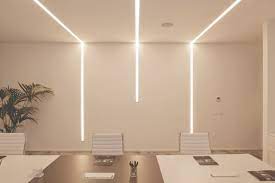Introduction
A linear LED light fixture is a lighting solution that has gained immense popularity due to its energy efficiency, longevity, and versatility. These fixtures are commonly used in various settings, from residential spaces to commercial and industrial applications. In this article, we will delve into the details of linear LED light fixtures, discussing their specifications, advantages, disadvantages, and their impact on power consumption, cost, and efficiency.
Specifications and Parameters
Linear LED light fixtures come in a wide range of sizes and specifications to meet different lighting needs. These fixtures are available in various lengths, typically ranging from 2 feet to 8 feet, with differing wattage options. Common specifications include:
- Power: Linear LED fixtures have a power rating that typically varies from 10 to 80 watts, depending on the size and brightness requirements.
- Dimensions: They come in different dimensions, with standard sizes such as 2x2 inches, 2x4 inches, and 4x4 inches.
- Color Temperature: The fixtures offer various color temperature options, from warm white (2700K-3500K) to cool white (5000K-6500K), allowing users to customize the ambiance.
- Lumen Output: Linear LED fixtures provide varying lumen outputs, often ranging from 1000 to 8000 lumens, ensuring adequate illumination for different spaces.
Advantages of Linear LED Light Fixtures
Energy Efficiency
Linear LED fixtures are highly energy-efficient. They consume significantly less power compared to traditional fluorescent or incandescent lighting. With a luminous efficacy of up to 160 lumens per watt, they provide brilliant illumination while minimizing power consumption. This energy efficiency translates to reduced electricity bills and a lower environmental footprint.
Longevity
Linear LED fixtures have an impressive lifespan, often exceeding 50,000 hours of operation. This extended lifespan results in reduced maintenance costs and the need for fewer replacements over the years.
Cost Savings
While the initial cost of linear LED fixtures may be higher than traditional lighting options, the long-term cost savings are substantial. Lower energy bills, reduced maintenance expenses, and longer replacement cycles contribute to a compelling return on investment (ROI).
Versatility
These fixtures can be used in various applications, including offices, retail spaces, warehouses, and even residential settings. They are adaptable and can be easily integrated into different architectural designs.
Disadvantages of Linear LED Light Fixtures
Initial Cost
As mentioned earlier, the upfront cost of purchasing linear LED fixtures can be relatively high. However, this cost is offset by the long-term savings in energy and maintenance.
Heat Generation
Linear LED fixtures can generate some heat, particularly in higher-wattage models. Adequate ventilation and heat management may be required in certain installations to prevent overheating.
Impact on Power Consumption and Efficiency
Linear LED fixtures significantly reduce power consumption when compared to traditional lighting options. For example, a 4-foot linear LED fixture with a power rating of 40 watts can replace a fluorescent fixture that consumes 80 watts. This translates to a 50% reduction in power usage.

Conclusion
In summary, linear LED light fixtures offer a range of benefits, including energy efficiency, cost savings, longevity, and versatility. They have the potential to greatly impact power consumption, reduce costs, and enhance efficiency in various applications. For more information on linear fixture LED options and specifications, you can visit comledlamp.com. Consider the specific needs of your space and lighting requirements when choosing the right linear LED fixture for your project. With their numerous advantages, these fixtures are a valuable investment in both residential and commercial settings.